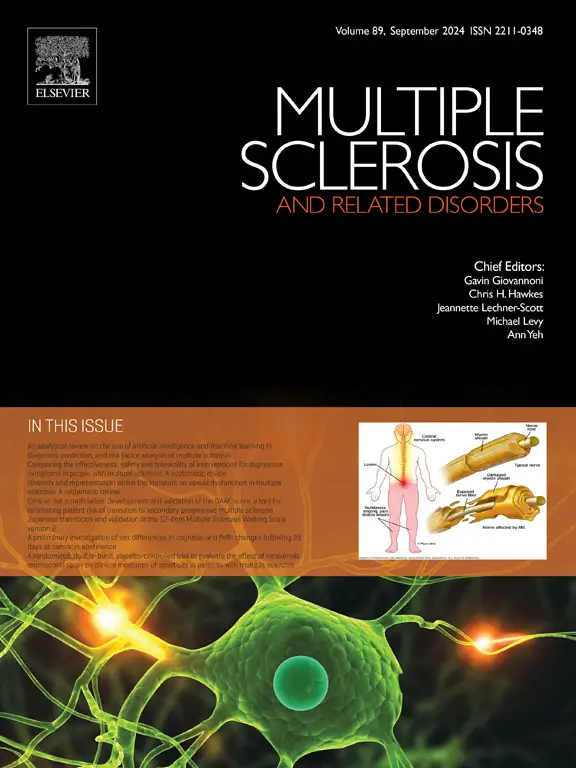The emergence of the novel coronavirus COVID-19 has raised concerns about the course of this disease in patients with multiple sclerosis (MS) and neuromyelitis optica spectrum disorder (NMOSD). This study aimed to evaluate the incidence, severity, and risk factors for a more severe course of COVID-19 among patients with MS and NMOSD. The study was conducted through the Czech nationwide ReMuS registry and included data from 12 MS centers covering 70 % of the Czech population of patients with MS and NMOSD. The results of the study provide important insights into the risks associated with COVID-19 in these patients, particularly in relation to their treatment and baseline characteristics.

Stastna, D., Menkyova, I., Drahota, J., Mazouchova, A., Adamkova, J., Ampapa, R., Grunermelova, M., Peterka, M., Recmanova, E., Rockova, P., Rous, M., Stetkarova, I., Valis, M., Vachova, M., Woznicova, I., & Horakova, D. (2021). Multiple sclerosis, neuromyelitis optica spectrum disorder and COVID-19: A pandemic year in Czechia. In Multiple Sclerosis and Related Disorders (Vol. 54, p. 103104). Elsevier BV. https://doi.org/10.1016/j.msard.2021.103104 PMID: 34216998
Abstract
Introduction: When the new coronavirus disease COVID-19 emerged, concerns were raised about its course in patients with multiple sclerosis (MS) and neuromyelitis optica spectrum disorder (NMOSD). This study was designed to evaluate the incidence, severity, and risk factors for a more severe course of COVID-19 in patients with MS and NMOSD.
Methods: From March 1, 2020 to February 28, 2021, 12 MS centers, representing 70 % of the Czech population of MS and NMOSD patients, reported laboratory-confirmed cases of COVID-19 through the Czech nationwide registry of MS and NMOSD patients (ReMuS). The main outcome was the severity of COVID-19 assessed on an 8-point scale with a cutoff at level 4 (radiologically confirmed pneumonia) according to the World Health Organization (WHO) COVID-19 severity score.
Results: We identified 958 patients with MS and 13 patients with NMOSD, 50 patients with MS and 4 patients with NMOSD had pneumonia, 3 patients with MS and 2 patients with NMOSD died. The prevalence of COVID-19 in MS patients appears to be similar to the general Czech population. Multivariate logistic regression found that higher body mass index (BMI [OR 1.07, 95% CI, 1.00-1.14]), higher age (OR per 10 years 2.01, 95% CI, 1.41-2.91), high-dose glucocorticoid therapy within 2 months before the onset of COVID-19 (OR 2.83, 95% CI, 0.10-7.48), and anti-CD20 therapy (OR 7.04, 95% CI, 3.10-15.87) were independent variables associated with pneumonia in MS patients. The increased risk of pneumonia in MS patients treated with anti-CD20 compared with patients on other disease-modifying therapy (same age, sex, BMI, high-dose glucocorticoid therapy within 2 months before the onset of COVID-19, presence of pulmonary comorbidity) was confirmed by propensity score matching (OR 8.90, 95% CI, 3.04-33.24). Reports of COVID-19 infection in patients with NMOSD are rare, but the available data to date suggest a high risk of a more severe course of COVID-19 and a higher mortality rate in patients with NMOSD. In our cohort, 4 patients with NMOSD (30.77 %) had a more severe course of COVID-19 and 2 patients (15.39 %) died.
Conclusion: The majority of MS patients had a mild course of COVID-19, in contrast to patients with NMOSD; however, higher BMI and age, anti-CD20 therapy, and high-dose glucocorticoid therapy during the 2 months before the onset of COVID-19 were associated with pneumonia. Based on this study, we have already initiated early administration of monoclonal antibodies against SARS-CoV-2 and preferential vaccination in the at-risk group.
You can read the full article in English on the magazine's website Multiple Sclerosis and Related Disorders.

